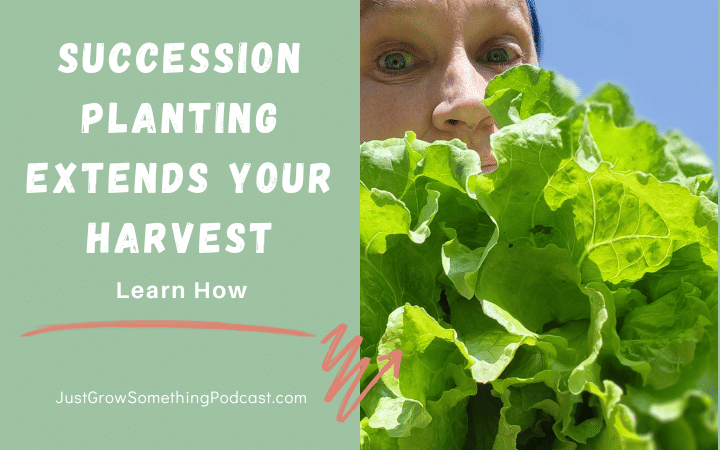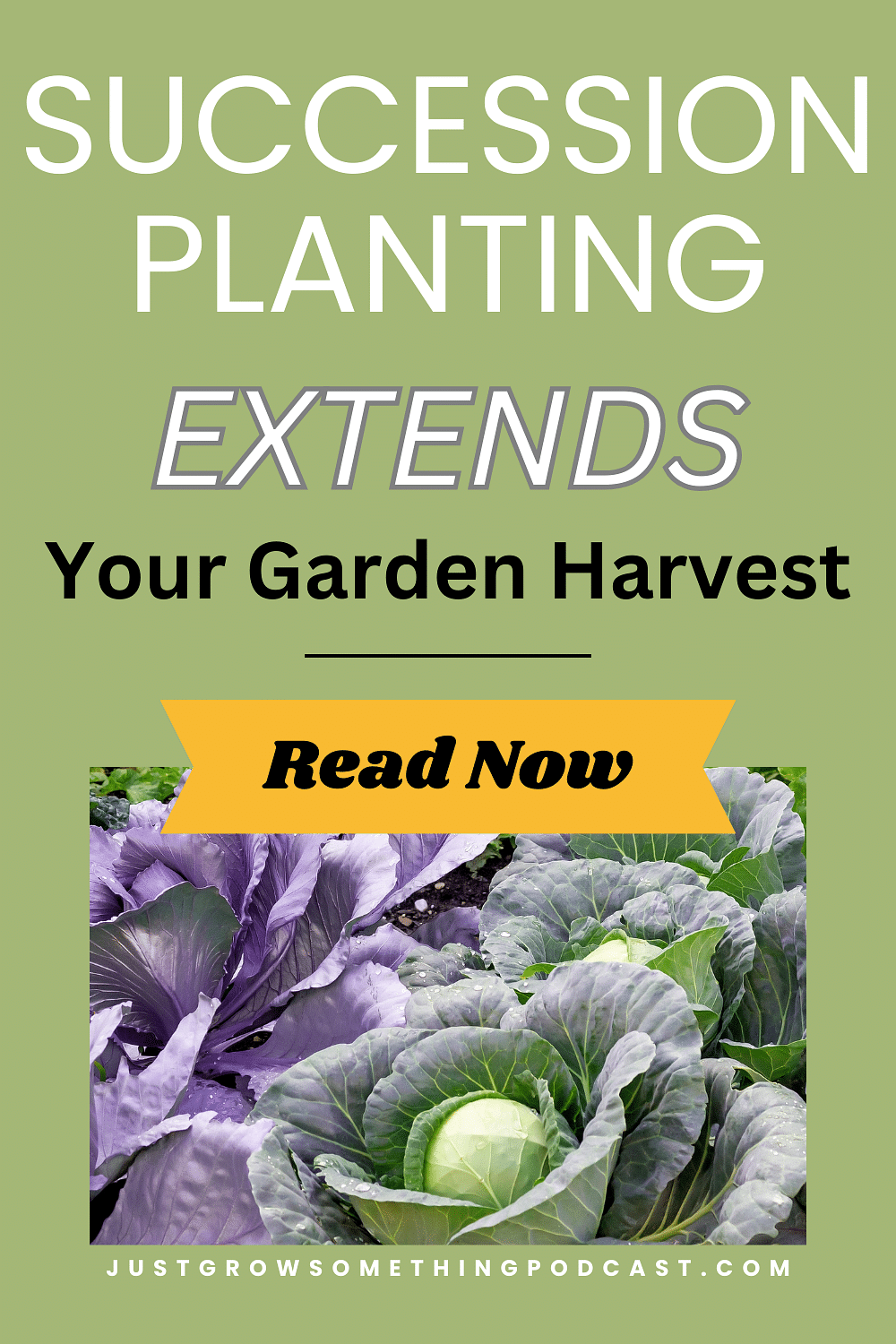
As we start to get our garden plans in order for this year, succession planting is something that absolutely should be included in our calendars and our garden maps. It’s really the best way to ensure not only do you have more to harvest throughout the season but that you take advantage of open spaces in the garden when one crop ends or the season changes.
What is succession planting?
 Essentially, succession planting is simply planting crops, either the same crop or crops that grow in different seasons, at different intervals throughout the growing season one after another. There are multiple ways this can happen and some of the intervals are just a few weeks while others are a few months.
Essentially, succession planting is simply planting crops, either the same crop or crops that grow in different seasons, at different intervals throughout the growing season one after another. There are multiple ways this can happen and some of the intervals are just a few weeks while others are a few months.
For example, in the spring, it’s the perfect time to plant leafy greens like lettuce. But, after a while, the leaf lettuce that you cut and allow to regrow may become leggy or bitter. And you can only harvest a head of lettuce once, even though you may be able to grow some loose-leaf from the stalk after you’ve cut it off. Rather than waiting until you’ve grown the complete crop, pulling it up, then replanting and having to wait another six weeks to harvest again, you can plant those lettuces successively every two weeks.
Picture a raised bed that’s dedicated to the spring lettuce. We’ll break the raised bed into three sections and plant the lettuce only in the first section to start. Then, two weeks later, we’ll plant in the second section. By this time, the first section is already growing at a steady click. Two weeks later, we’ll plant the third section. Now, the entire bed is planted but all three sections are growing at different stages. When it’s time to harvest the first section, you can usually harvest those plants steadily for about two weeks. Once they’ve been exhausted, the next section of lettuce is ready to harvest. Harvest each section of the bed continuously and you’ll have gotten six weeks of harvest off those lettuce plantings without being overrun by lettuce and without a break in your salads. Once the weather is no longer conducive to growing lettuce, you can plant a summer crop in place of the lettuce or plant a cover crop like buckwheat as a placeholder, then start succession plantings all over again in late summer for a fall lettuce crop to take you all the way through to the first frost.
Types of Successions
 To plan successions like this in the garden, we need to consider how quickly the plants mature and what kind of weather they like. Rapid succession plants are those that mature in less than 60 days, sometimes as short as 30 days. These are candidates for staggered plantings every two to three weeks as long as the weather is conducive. Succession plantings like this can be done to get several crops of just about anything. Some common ones are lettuce, radishes, baby greens, and green onions grown from sets … anything that you may want to have continuously but that wouldn’t hold well in the garden for more than a couple of weeks waiting to be picked or that is fairly perishable after harvest and won’t store well long term. Often times these are cool-season crops and the successions can be repeated again for fall harvests.
To plan successions like this in the garden, we need to consider how quickly the plants mature and what kind of weather they like. Rapid succession plants are those that mature in less than 60 days, sometimes as short as 30 days. These are candidates for staggered plantings every two to three weeks as long as the weather is conducive. Succession plantings like this can be done to get several crops of just about anything. Some common ones are lettuce, radishes, baby greens, and green onions grown from sets … anything that you may want to have continuously but that wouldn’t hold well in the garden for more than a couple of weeks waiting to be picked or that is fairly perishable after harvest and won’t store well long term. Often times these are cool-season crops and the successions can be repeated again for fall harvests.
Mid-range succession crops are those that mature between 60 and 90 days. These are usually warm season crops like those bush beans and sweet corn we talked about. These crops usually give their entire harvest up over the course of about two weeks and can be planted in multiple successions in smaller plots to spread out that harvest.
But there are mid-range succession plants that don’t do well in the summer heat. These are good candidates for a split succession; planting an early crop to reach maturity in the first part of the season then planted again later in summer for a fall harvest, often with something else planted in between during the hottest part of the season. Starting a large crop of carrots in the spring, can clear the way for a succession of sweet corn in the summer, and then the corn can be cleared in time to plant more carrots for fall harvest and overwintering. This is a succession that takes advantage of seasonal temperatures to grow what we want but without leaving empty space in the garden beds.
Another twist to succession planting is to plant varieties that mature at different rates. If you want to grow sweet corn, you can choose three different varieties of corn that mature about four weeks apart, plant them all at the same time in the spring and have three smaller harvests throughout the season. If you have a long, cool spring, it may be practical for you to plant three different varieties of broccoli that mature at different rates so that each head can be harvested at its peak, and you get a continuous harvest over a period of several weeks.
Succession planting also works for crops that may experience heavy pest pressure. Some examples of this are zucchini and cucumbers. Plant the initial crop as started seedlings. This gives them a jump on the pests. At the same time, plant the next succession as seeds straight in the ground or start them indoors if it’s a crop that needs to be transplanted. Once that second crop has come up or has been transplanted and it’s getting ready to produce, the first round of plants is usually succumbing to the pests. That’s when you pull those plants and plant a third round, either straight from seed again or as transplants. By the time the third round of plants gets to maturity, the middle succession will likely be done, and you can pull those while starting the harvest from the third succession.
Relay Planting
Another aspect of succession planting is relay planting. This is sort of a combination of succession planting and the interplanting we talked about in this podcast episode. These are for long succession crops that take longer than 90 days to mature or will be in the beds for longer than 90 days due to an extended harvest. While you likely won't plant multiple crops of these plants, they are candidates for taking space once another crop has vacated the plot or vice versa. They’re often paired with mid-range or rapid succession plants.
In relay planting, you have one crop that’s been planted and is already on its way to maturity. Then, you take a second crop and plant it in and among the first one. Typically, this is whatever crop is going to take the place of the first one when it’s mature. In this way, the second crop gets a little bit of a head start while the first one is still in the ground, maximizing the use of the space. This can be done with just about any crop combination so long as they don’t compete with each other too much for nutrients.
Let’s go back to our lettuce bed. Let’s say I’ve got my three crops of lettuce going in each section of that bed. Eventually, when the weather warms up, it’s going to be too hot to grow lettuce and I’m going to plant my tomatoes there. Once the weather conditions are right, I can just plop those tomato seedlings right in among my lettuce plants. Since the tomato plants are fairly small when they go in, they’re not going to overshadow the lettuce enough to slow their growth. And, since lettuce isn’t a really heavy feeder, it’s not going to take much away from the tomatoes in terms of nutrients. Once the lettuce matures and is harvested, the tomatoes have plenty of space to continue to grow and they’ve gotten a head start, rather than waiting to be planted until after the lettuce was already harvested.
This works the opposite way, too. In the late summer when the weather is still warm, you can plant lettuce seeds directly underneath those tomato plants. The soil will be warm enough to germinate those seeds, but the tomato plants will shade the lettuce sprouts to keep them from getting wilted in the summer heat. As the lettuce matures, the lower leaves of the tomato plants can be pruned to allow for more room for the lettuce and allow for more light to come in as the days cool off. You can be harvesting lettuce and tomatoes at the same time toward the late fall and when the first frost is imminent, pull those tomato plants, cover the lettuce with some frost cloth, and continue to harvest lettuce until a hard freeze hits. All this in one bed, which saves space in the other areas of the garden for other crops.
This goes for just about any of the leafy green crops that like the cooler weather that can be planted with any of the taller heat-loving summer crops, as long as you’re sure they’ll be good companions.
There are lots of options for relay planting and you can get super creative with it.
And, yes, succession planting works well in containers, too. This can be done in multiple containers with different planting dates or planted all at once with different maturity dates.
Relay planting also works well in containers and is a really great way to get more out of a small space. Just keep the nutrient, sunlight, and space requirements of each plant in mind and you can really maximize the space in your containers.
Your friend in the garden,

